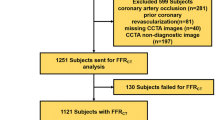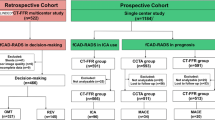Abstract
Objectives
To explore downstream management and outcomes of machine learning (ML)–based CT derived fractional flow reserve (FFRCT) strategy compared with an anatomical coronary computed tomography angiography (CCTA) alone assessment in participants with intermediate coronary artery stenosis.
Methods
In this prospective study conducted from April 2018 to March 2019, participants were assigned to either the CCTA or FFRCT group. The primary endpoint was the rate of invasive coronary angiography (ICA) that demonstrated non-obstructive disease at 90 days. Secondary endpoints included coronary revascularization and major adverse cardiovascular events (MACE) at 1-year follow-up.
Results
In total, 567 participants were allocated to the CCTA group and 566 to the FFRCT group. At 90 days, the rate of ICA without obstructive disease was higher in the CCTA group (33.3%, 39/117) than that (19.8%, 19/96) in the FFRCT group (risk difference [RD] = 13.5%, 95% confidence interval [CI]: 8.4%, 18.6%; p = 0.03). The ICA referral rate was higher in the CCTA group (27.5%, 156/567) than in the FFRCT group (20.3%, 115/566) (RD = 7.2%, 95% CI: 2.3%, 12.1%; p = 0.003). The revascularization-to-ICA ratio was lower in the CCTA group than that in the FFRCT group (RD = 19.8%, 95% CI: 14.1%, 25.5%, p = 0.002). MACE was more common in the CCTA group than that in the FFRCT group at 1 year (HR: 1.73; 95% CI: 1.01, 2.95; p = 0.04).
Conclusion
In patients with intermediate stenosis, the FFRCT strategy appears to be associated with a lower rate of referral for ICA, ICA without obstructive disease, and 1-year MACE when compared to the anatomical CCTA alone strategy.
Key Points
• In stable patients with intermediate stenosis, ML-based FFR CT strategy was associated with a lower referral ICA rate, a lower normalcy rate of ICA, and higher revascularization-to-ICA ratio than the CCTA strategy.
• Compared with the CCTA strategy, ML-based FFR CT shows superior outcome prediction value which appears to be associated with a lower rate of 1-year MACE.
• ML-based FFR CT strategy as a non-invasive “one-stop-shop” modality may be the potential to change diagnostic workflows in patients with suspected coronary artery disease.




Similar content being viewed by others
Abbreviations
- CABG:
-
Coronary artery bypass grafting
- CAD:
-
Coronary artery disease
- CCTA:
-
Coronary computed tomography angiography
- FFR:
-
Fractional flow reserve
- FFRCT :
-
CT derived fractional flow reserve
- HR:
-
Hazard ratio
- ICA:
-
Invasive coronary angiography
- LAD:
-
Left anterior descending artery
- LCX:
-
Left circumflex
- MACE:
-
Major adverse cardiovascular events
- ML:
-
Machine learning
- OMT:
-
Optimal medical therapy
- PCI:
-
Percutaneous coronary intervention
- RCA:
-
Right coronary artery
- RD:
-
Risk difference
References
Shaw LJ, Hausleiter J, Achenbach S et al (2012) Coronary computed tomographic angiography as a gatekeeper to invasive diagnostic and surgical procedures: results from the multicenter CONFIRM (Coronary CT Angiography Evaluation for Clinical Outcomes:an International Multicenter) registry. J Am Coll Cardio 60:2103–2114
Williams MC, Hunter A, Shah ASV et al (2016) Use of coronary computed tomographic angiography to guide management of patients with coronary disease. J Am Coll Cardiol. 67:1759–1768
Knuuti J, Wijns W, Saraste A et al (2020) 2019 ESC guidelines for the diagnosis and management of chronic coronary syndromes. Eur Heart J 41:407–477
Douglas PS, Hoffmann U, Patel MR et al (2015) Outcomes of anatomical versus functional testing for coronary artery disease. N Engl J Med 372:1291–1300
SCOT-HEART Investigators (2015) CT coronary angiography in patients with suspected angina due to coronary heart disease (SCOT-HEART): an open-label, parallel-group, multicentre trial. Lancet 385:2383–2391
Budoff MJ, Nakazato R, Mancini GB et al (2016) CT angiography for the prediction of hemodynamic significance in intermediate and severe lesions: head-to-head comparison with quantitative coronary angiography using fractional flow reserve as the reference standard. JACC Cardiovasc Imaging 9:559–564
Jensen JM, Botker HE, Mathiassen ON et al (2018) Computed tomography derived fractional flow reserve testing in stable patients with typical angina pectoris: influence on downstream rate of invasive coronary angiography. Eur Heart J Cardiovasc Imaging 19:405–414
Schwartz FR, Koweek LM, Nørgaard BL (2019) Current evidence in cardiothoracic imaging: computed tomography-derived fractional flow reserve in stable chest pain. J Thorac Imaging 34:12–17
Tesche C, Gray HN (2020) Machine learning and deep neural networks applications in coronary flow assessment: the case of computed tomography fractional flow reserve. J Thorac Imaging 35:S66–S71
Fairbairn TA, Nieman K, Akasaka T et al (2020) Real-world clinical utility and impact on clinical decision-making of coronary computed tomography angiography-derived fractional flow reserve: lessons from the ADVANCE Registry. Eur Heart J 39:3701–3711
Patel MR, Norgaard BL, Fairbairn TA et al (2020) 1-year impact on medical practice and clinical outcomes of FFRCT: The ADVANCE registry. JACC Cardiovasc Imaging 13:97–105
Qiao HY, Tang CX, Schoepf UJ et al (2020) Impact of machine learning-based coronary computed tomography angiography fractional flow reserve on treatment decisions and clinical outcomes in patients with suspected coronary artery disease. Eur Radiol 30:5841–5851
Tesche C, Vliegenthart R, Duguay TM et al (2020) Coronary computed tomographic angiography-derived fractional flow reserve for therapeutic decision making. Am J Cardiol 120:2121–2127
Chinnaiyan KM, Akasaka T, Amano T et al (2020) Rationale, design and goals of the HeartFlow Assessing Diagnostic Value of Non-invasive FFRCT in Coronary Care (ADVANCE) registry. J Cardiovasc Comput Tomog 11:62–67
Norgaard BL, Hjort J, Gaur S et al (2020) Clinical use of coronary CTA-derived FFR for decision-making in stable CAD. JACC Cardiovasc Imaging 10:541–550
Abbara S, Blanke P, Maroules CD et al (2016) SCCT guidelines for the performance and acquisition of coronary computed tomographic angiography. J Cardiovasc Comput Tomogr. 10:435–449
Cury RC, Abbara S, Achenbach S et al (2020) CAD-RADS(TM) Coronary Artery Disease - Reporting and Data System. An expert consensus document of the Society of Cardiovascular Computed Tomography (SCCT), the American College of Radiology (ACR) and the North American Society for Cardiovascular Imaging (NASCI). Endorsed by the American College of Cardiology. J Cardiovasc Comput Tomogr 10:269–281
Nørgaard BL, Fairbairn TA, Safian RD et al (2019) Coronary CT angiography-derived fractional flow reserve testing in patients with stable coronary artery disease: recommendations on interpretation and reporting. Radiol Cardiothorac Imaging 1:e190050
Hicks KA, Tcheng JE, Biykem B et al (2015) 2014 ACC/AHA key data elements and definitions for cardiovascular endpoint events in clinical trials. J Nucl Cardiol 66:403–469
Williams MC, Moss A, Nicol E, Newby DE (2017) Cardiac CT improves outcomes in stable coronary heart disease: results of recent clinical trials. Curr Cardiovasc Imaging Rep 10:14
Jørgensen ME, Andersson C, Nørgaard BL et al (2017) Functional testing or coronary computed tomography angiography in patients with stable coronary artery disease. J Am Coll Cardiol 69:1761–1770
Lu MT, Ferencik M, Roberts R et al (2017) Noninvasive FFR derived from coronary CT angiography: management and outcomes in the PROMISE Trial. JACC Cardiovasc Imaging 10:1350–1358
Ihdayhid AR, Norgaard BL, Gaur S et al (2019) Prognostic value and risk continuum of noninvasive fractional flow reserve derived from coronary CT angiography. Radiology 292:343–351
Chinnaiyan KM, Safian RD, Gallagher ML et al (2019) Clinical use of CT-derived fractional flow reserve in the emergency department. JACC Cardiovasc Imaging 13:452–461
Norgaard BL, Terkelsen CJ, Mathiassen ON et al (2018) Coronary CT angiographic and flow reserve-guided management of patients with stable ischemic heart disease. J Am Coll Cardiol 72:2123–2134
Patel MR, Peterson ED, Dai D et al (2010) Low diagnostic yield of elective coronary angiography. N Engl J Med 362:886–895
Douglas PS, Gianluca P, Hlatky MA et al (2015) Clinical outcomes of fractional flow reserve by computed tomographic angiography-guided diagnostic strategies vs. usual care in patients with suspected coronary artery disease: the prospective longitudinal trial of FFRCT: outcome and resource impacts study. Eur Heart J 36:3359–3367
Finck T, Hardenberg J, Will A et al (2019) Ten-year follow-up after coronary computed tomography angiography in patients with suspected coronary artery disease. JACC Cardiovasc Imaging 12:1330–1338
Nielsen LH, Botker HE, Sorensen HT et al (2017) Prognostic assessment of stable coronary artery disease as determined by coronary computed tomography angiography: a Danish multicentre cohort study. Eur Heart J 38:413–421
Dewey M, Rief M, Martus P et al (2016) Evaluation of computed tomography in patients with atypical angina or chest pain clinically referred for invasive coronary angiography: randomised controlled trial. BMJ 355:i5441
Chang HJ, Lin FY, Gebow D et al (2018) Selective referral using CCTA versus direct referral for individuals referred to invasive coronary angiography for suspected CAD: a randomized, controlled, open-label trial. JACC Cardiovasc Imaging 12:1303–1312
De Bruyne B, Pijls NH, Kalesan B et al (2012) Fractional flow reserve-guided PCI versus medical therapy in stable coronary disease. N Engl J Med 367:991–1001
De Bruyne B, Fearon WF, Pijls NH et al (2015) Fractional flow reserve-guided PCI for stable coronary artery disease. N Engl J Med 371:1208–1217
Ciccarelli G, Barbato E, Toth GG et al (2015) Angiography versus hemodynamics to predict the natural history of coronary stenoses: Fractional flow reserve versus in multivessel evaluation 2 substudy. Circulation 137:1475–1485
Coenen A, Kim YH, Kruk M et al (2018) Diagnostic accuracy of a machine-learning approach to coronary computed tomographic angiography-based fractional flow reserve: result from the MACHINE consortium. Circ Cardiovasc Imaging 11:e007217
Tang CX, Wang YN, Zhou F et al (2019) Diagnostic performance of fractional flow reserve derived from coronary CT angiography for detection of lesion-specific ischemia: A multi-center study and meta-analysis. Eur J Radiol 116:90–97
Acknowledgements
The authors gratefully acknowledge the financial support of the National Key Research and Development Program of China (2017YFC0113400 for L.J.Z.).
Funding
This study was supported by the National Key Research and Development Program of China (2017YFC0113400 for L.J.Z.).
Author information
Authors and Affiliations
Corresponding authors
Ethics declarations
Guarantor
The scientific guarantor of this publication is Long Jiang Zhang.
Disclosures
U. Joseph Schoepf is a consultant for and/or receives research support from Astellas, Bayer, Bracco, Elucid BioImaging, General Electric, Guerbet, HeartFlow, and Siemens Healthineers. The other authors have no conflicts of interest to disclose.
Statistics and biometry
Meng Jie Lu kindly provided statistical advice for this manuscript. One of the authors has significant statistical expertise. No complex statistical methods were necessary for this paper.
Informed consent
All participants provided written informed consent.
Ethical approval
Institutional Review Board approval was obtained.
Methodology
• Prospective
• Observational
• Performed at one institution
Additional information
Publisher’s note
Springer Nature remains neutral with regard to jurisdictional claims in published maps and institutional affiliations.
Supplementary Information
ESM 1
(DOCX 136 kb)
Rights and permissions
About this article
Cite this article
Qiao, H.Y., Tang, C.X., Schoepf, U.J. et al. One-year outcomes of CCTA alone versus machine learning–based FFRCT for coronary artery disease: a single-center, prospective study. Eur Radiol 32, 5179–5188 (2022). https://doi.org/10.1007/s00330-022-08604-x
Received:
Revised:
Accepted:
Published:
Issue Date:
DOI: https://doi.org/10.1007/s00330-022-08604-x




